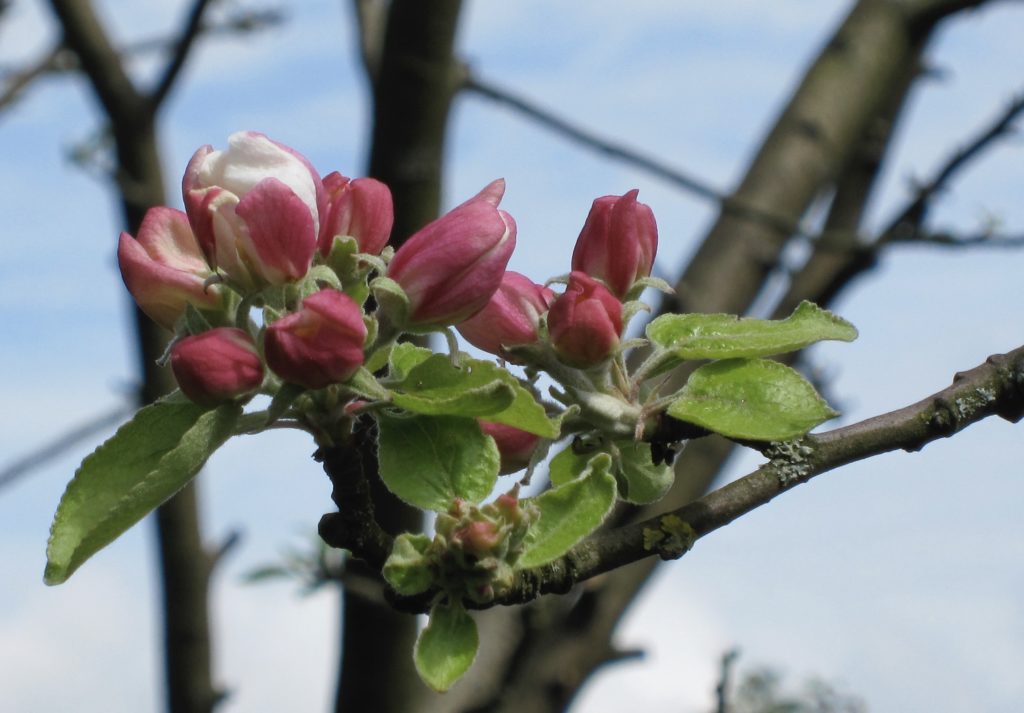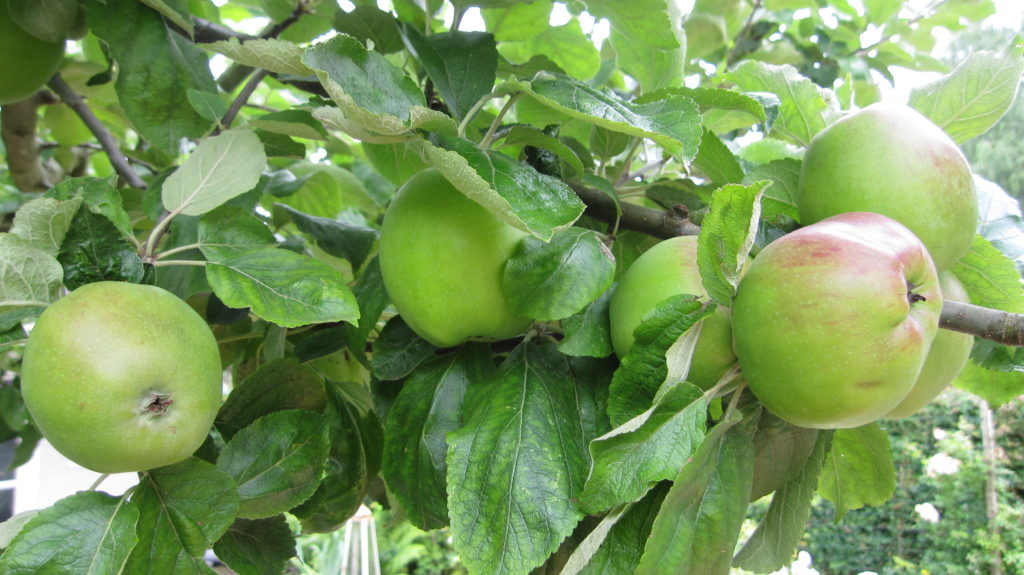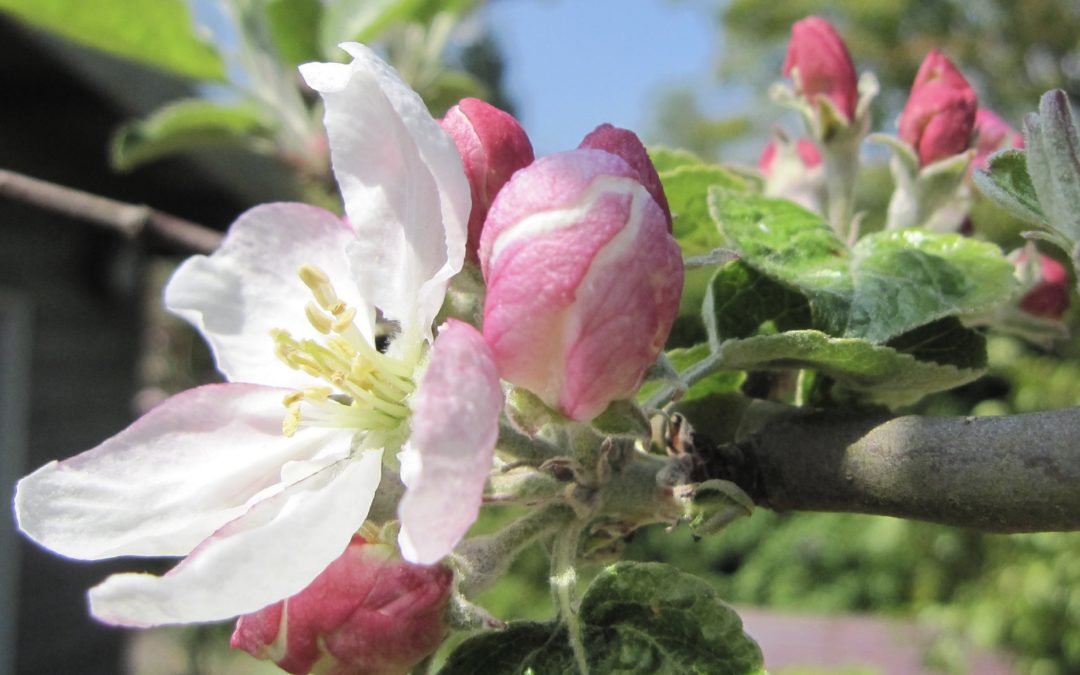Just as the blossom on a fruit tree grows into healthy fruit under the right circumstances, our wishes also grow into a reality we desire under the right circumstances.
From: De creatiespiraal, natuurlijke weg van wens naar werkelijkheid, Marinus Knoope
The power of the sun
The beginning of May. Spring is visible everywhere. The fruit trees in our allotment, including the old apple tree in the middle of the garden, are in bloom. I was a little concerned because of the light frost we’ve had in recent weeks. The delicate blossom of the apple tree cannot withstand this. Fortunately he survived. It is currently in full bloom and refreshes itself from the increasing warmth of the spring sun.
Phases/cycles in nature
It has been years since I was impressed by the process as described by Marinus Knoope in his book about ‘The natural way from purpose into manifestation’. (Subtitel loosely translated bij W.V.) In describing this process, he uses the image of the cycle of nature. In the transition from autumn to winter, the tree’s attention is at the roots, in the transition from winter to spring at the blossom, in the transition to summer at the leaves, and at the transition to autumn at the fruit. A similar process with phases that follow each other like links in a chain is also known in psychosynthesis counseling. The process of becoming more aware of who you are and what you want to actually living your own answers. From Purpose to Manifestation.
We are nature
A beautiful picture of the process from purpose into manifestation as it takes place every year in nature. As humans we are part of this nature and many of the processes we observe there, we can also discover within ourselves. Just as a tree inhales carbon dioxide through its leaves and exhales oxygen, we as humans inhale the oxygen and exhale the carbon dioxide. In this way we participate in this cycle of nature.
Selfconsciousness
Yet there is something that distinguishes us from the trees, plants and animals. We have consciousness, self-consciousness. We are aware of ourselves and can also influence this awareness. We do this influencing our consciousness with an inner drive that we attribute to the ‘Will’ in psychosynthesis. We are able to consciously want something, to focus our attention on something or to let it go. That makes us a special ‘species’. And this, in my view, is where the great challenge we face as human beings lies. The challenge to become aware of who we are and what we want/wish.
Personal Psychosynthesis
This challenge (or invitation) to reflect on ‘Who am I and What do I want’ brings me to the process of Psychosynthesis. In my personal psychosynthesis process and the psychosynthesis process where I can guide clients who register in practice.
Call of Self
In its most basis sense, psychosynthesis is simply a name for the proces of personal growth………In its more specific sense, psychosynthesis is a name for the conscious attempt to cooperate with the natural process of development. All living things contain within them a drive to evolve, to become the fullest realization of themselves. This process can be sup[ported consciously, and psychosynthesis is one means to do this.
From: The Call of Self, Chapter 1, Psychosynthesis: a Brief Overview, Dorothy Firman.
Inner drive
As far as I’m concerned, it is this ‘drive to evolve’ that we have in common with, for example, the apple tree in our allotment. The ‘drive’ of the apple tree is to manifest apples after the blossom. The ‘drive’ that we learn to work with in psychosynthesis is the drive to become who you are and to manifest what you want. The way in which psychosynthesis gives shape to this is, among other things, through the process of discovering what you want (Purpose) towards manifesting (putting into practice) to this goal. With this you are increasingly able to make conscious decisions.
Automatic pilot
Much of what we put into practice we often do unconsciously and on autopilot. This is a great mechanism by which we don’t have to constantly bring awareness to what we want to do. (Imagine that with every action while cycling or driving you had to consciously think about what to do!) The ‘problems’ (read complaints) arise when this autopilot hinders us in what we really want.
Assagioli describes in ‘The Act of Will’, the different phases of the desired action and the objective to which you can direct this action. And just like every phase in the growth process of the apple tree, the phases in the volitional process of our human actions are just as important as the links in a chain. Assagioli writes:
I have found – and this can easily be self-confirmed – that the main cause of failure in completing a will process is that people often have difficulty passing through some specific stage; in other words, at some point in the sequence, they get stuck.
From: The Act of Will, Roberto Assagioli.

Phases of the will process
Purpose:
It’s important to know what you want. What is your purpose, what is your intention and what are important values for you. Values that match who you are and want to be. In the first introductory meeting I always ask clients to choose an image for their purpose. It is immediately the starting point of the guidance or therapy. What do they want to work on. Usually it is clear what they do not want and the request for help is often determined by complaints or symptoms (by automatic pilot impulses). Imagining a purpose or intention is then very important to indicate the direction they would like to move to.
Deliberation:
In this phase you investigate whether your I and your will to want are free. To be free from and to be free to. For example, you may have a purpose that not only evokes positive feelings, but also negative feelings. Feelings such as fear or resistance. Suppose you have a longing for connection and closeness, but the moment you want to give it concrete shape, something is hindering you, for example fear or shame. Usually, every force creates a counter force. It is then important to take this into account in this phase and, where necessary, to pay some extra attention to what makes the I and the will to want unfree. For example, it may be that part of ourselves really wants something and at the same time another part may not dare or is not yet willing to give up something.
Choice:
Some people make a decision too quickly without making room for this second phase (consideration) and others have difficulty choosing or sometimes leave the choice to someone else. Choosing means not only saying yes to the choice you make, but also learning to say no to the choices you don’t make but could have made. If you have carefully entered the previous phases, there is a good chance that your choice is in line with your purpose and personal values.
Affirmation:
Once you have made the choice, it is important to confirm it. With this you bring extra energy to the will decision. This can be done, for example, by expressing your purpose and the choice you have made in words or images. Suppose you plan to stop smoking or drinking. It can then help to reinforce your choice to stop by sharing this with others and expressing your choice. Or you write your choice in a few words on paper and hang it in different places in your house where it stands out, like a ‘bumper sticker’.
Planning:
Once you’ve chosen and confirmed your choice, it’s time to plan how you’re going to go about it. It is important to formulate clear and achievable steps that take time, circumstances and possibilities into account.
Manifestation:
Ultimately, it is then time for you to actually put your purpose into practice. You will eventually do what you want.
In psychosynthesis counseling these phases of the will process are always discussed. And it really can’t be otherwise. Every (conscious) choice goes through these phases in order to eventually be able to come from Purpose to manifestation. And of course not every choice is actually realized and manifested. This is often the reason for clients to seek help. Many requests for help can be traced back to a ‘conflict’ in the process from wish to reality.

Malan’s Triangels
In counseling, both individual and group therapy, I use Malan’s conflict triangle. This conflict triangle is used (mostly in psychotherapy) to determine which inner dynamics play a role in the client’s complaints/request for help. This makes old patterns (survival mechanisms) visible, after which it is then examined which new patterns can re-establish the connection with one’s own purpose. Becoming aware of and activating the will process, as a guiding mechanism in human action, is an important intervention in psychosynthesis counseling. The three points of this conflict triangle correspond to the multidimensional layering of the psychosynthesis Ei-diagram. (the lower, middle and higher unconscious) Read more about the Egg diagram here.
The Will as ‘drive to evolve’ in individual and group therapy
I have tried to provide more insight into how we use the will process as an ‘inner drive’ in psychosynthesis counseling, in both individual and group therapy, to be able to move from purpose to manifestation. The most important thing here is to become aware that we do not just have a will, but that we are ‘willers’. When I look around on our allotment garden, how nature is currently unfolding in an almost incomprehensible process and reacting to the influence of the power of the Sun, I can only make a comparison with the solar power in ourselves (Self with a capital S), that inner ‘drive to evolve’ that is closely connected with the Will. The will to become who you are!
The spontaneous movement in all of us focuses on connection.
Laurence Heller
There is – as with plants that spontaneously move towards the sun – within each of us, an impulse towards connection with ourselves and with others, no matter how much withdrawn or isolated, or however great the trauma we have have incurred.
